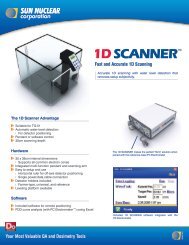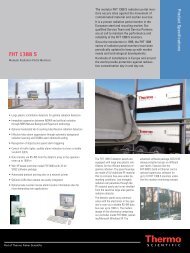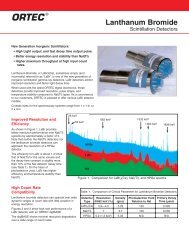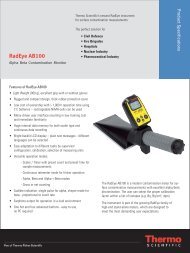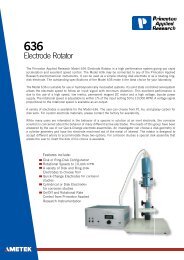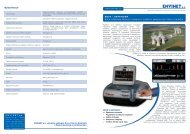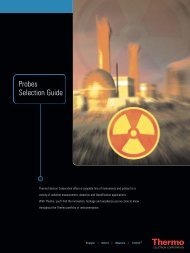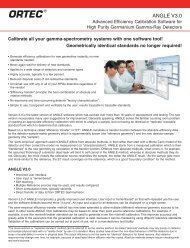semiconductor radiation detectors short form catalog - Envinet a.s.
semiconductor radiation detectors short form catalog - Envinet a.s.
semiconductor radiation detectors short form catalog - Envinet a.s.
Create successful ePaper yourself
Turn your PDF publications into a flip-book with our unique Google optimized e-Paper software.
ORTEC ®<br />
SEMICONDUCTOR RADIATION DETECTORS<br />
SHORT FORM CATALOG
ORTEC Semiconductor Radiation Detectors Short Form Catalog<br />
The invention of <strong>semiconductor</strong> photon <strong>detectors</strong> based on large cryogenically cooled germanium and silicon diodes<br />
began in the 1950’s. Today ORTEC offers the widest range of <strong>semiconductor</strong> photon <strong>detectors</strong> up to very large crystal<br />
sizes.<br />
These <strong>detectors</strong> are capable of very high energy resolution and since their invention have proved highly desirable in<br />
many applications, most recently in relation to homeland security where, the “gold standard” in these measurements is<br />
considered to be a high purity germanium (HPGe) detector.<br />
Classically, cooling for germanium and silicon <strong>semiconductor</strong> photon <strong>detectors</strong> has been implemented by the use of<br />
liquid cryogens, most commonly liquid nitrogen. Since the mid 1980’s ORTEC has pioneered the use of mechanical<br />
coolers, at this date having delivered more mechanically cooled HPGe <strong>detectors</strong> than all other manufacturers combined.<br />
ORTEC HPGe <strong>detectors</strong> are now in use world-wide in applications as diverse as nuclear structure physics and the<br />
prevention of illicit nuclear materials trafficking at the world’s largest ports of commerce.<br />
ORTEC introduced the first silicon surface barrier <strong>detectors</strong> for charged particle spectroscopy in the early 1960’s when<br />
the company was starting out. A broad product range to cover a wide variety of applications rapidly developed. Today<br />
there are no fewer than 13 product lines of <strong>semiconductor</strong> charged particle <strong>detectors</strong> available from ORTEC for a wide<br />
range of applications.<br />
This <strong>short</strong> <strong>form</strong> <strong>catalog</strong> is intended to provide overview in<strong>form</strong>ation to aid in the initial consideration of either HPGe<br />
photon <strong>detectors</strong> or silicon charged particle <strong>detectors</strong>. Further applications in<strong>form</strong>ation and detailed product<br />
Contents<br />
Part A: Photon Detectors..................................2<br />
Benefits and Specifications Common to All<br />
ORTEC HPGe Photon Detectors .....................3<br />
GEM and Profile GEM......................................3<br />
Profile Series GEM...........................................3<br />
GAMMA-X (GMX) ............................................4<br />
GWL Series HPGe Well ...................................4<br />
GLP and SLP....................................................5<br />
Detectors for Special Applications....................6<br />
Safeguards and Non-Destructive Assay...........6<br />
PINS-GMX........................................................6<br />
Lung Monitor.....................................................6<br />
Pipe Gage Monitor............................................6<br />
Shallow-Hole Probe..........................................7<br />
Submergible Photon Detector ..........................7<br />
Configuration Guidelines ..................................8<br />
X-COOLER II .................................................10<br />
Detector Options.............................................11<br />
All-in-One Spectrometer Solutions .................12<br />
IDM .................................................................12<br />
Micro-trans-SPEC...........................................12<br />
trans-SPEC-DX-100T .....................................13<br />
Part B: Charged Particle Detectors ................14<br />
ULTRA and ULTRA-AS...................................14<br />
ULTRA CAM ...................................................14<br />
R Series..........................................................15<br />
Heavy Ion Detectors .......................................15<br />
Backscatter Detectors ....................................15<br />
Totally Depleted ..............................................15<br />
Partially Depleted ...........................................15<br />
BETA-X Cooled Spectrometer ........................16<br />
Charged Particle Detector Data Summary and<br />
Selection Chart...............................................16<br />
Charged Particle Detector Mounting ..............17<br />
specifications are available from the ORTEC Website, which is frequently<br />
referenced throughout this document.<br />
Part A: Photon Detectors<br />
Getting Started. . . how to make the right choice of<br />
photon detector?<br />
Choosing the correct detector for your specific application involves many<br />
criteria. The recommendations in our “How to Choose” document are<br />
intended to guide a user to the detector likely to be best suited for the<br />
application.<br />
Download the Guide at<br />
www.ortec-online.com/download/How-to-Choose-Detector.pdf<br />
Here you will learn the relevance of all of the following in your application<br />
choice:<br />
• N- or P-type?<br />
• Detector size?<br />
• Relative versus absolute efficiency?<br />
• Resolution?<br />
• Peak to Compton Ratio?<br />
• Count rate limits?<br />
• Low background <strong>detectors</strong>?<br />
• Sample geometry?<br />
. . . and much more<br />
Categories of Semiconductor Photon Detectors<br />
ORTEC offers a wide range of <strong>semiconductor</strong> photon <strong>detectors</strong> and<br />
options which cover energies for x rays in the few hundred eV range up to<br />
gamma rays in the 10 MeV and above. As appropriate, these <strong>detectors</strong> are<br />
made of high purity germanium (HPGe of both P and N type), or lithium<br />
drifted silicon (SiLi). All of these must be cryogenically cooled.<br />
2
ORTEC Semiconductor Radiation Detectors Short Form Catalog<br />
Benefits and Specifications Common to All ORTEC HPGe Photon Detectors<br />
• Wide range of efficiencies, to 150% in P-type and 100% in N-type, even higher on request.<br />
• Excellent energy resolution and peak symmetry.<br />
• Specified crystal dimensionns in Profile models.<br />
• SMART bias option. See page ?<br />
• Harsh Environment (-HE) option. See page ?<br />
• Low Background carbon fiber endcap options. See page ?<br />
• PLUS preamplifier option for ultra-high-rate applications. See page ?<br />
• Huge configuration flexibility with PopTop, Streamline, and mechanically cooled options.<br />
GEM and Profile GEM Detectors<br />
The majority of Gamma Spectroscopy applications, such as those<br />
found in counting laboratories, involve the energy range ~40 keV<br />
upward.<br />
GEM and Profile Series GEM <strong>detectors</strong> are coaxial germanium<br />
<strong>detectors</strong> with a conventional diffused lithium outer contact of<br />
~700 micron which makes them suitable for spectroscopy from<br />
around 40 keV. The inner contact is a boron ion implant. The FX<br />
series of Profile GEMs feature a proprietary thin front entrance<br />
window equivalent to about 10 micron of germanium, allowing<br />
spectroscopy at ~10 keV and above. GEM <strong>detectors</strong> are specified<br />
in terms of relative efficiency at 1.33 MeV (ref. IEEE 325), whereas<br />
Profile Series GEM <strong>detectors</strong> are specified by crystal dimensions,<br />
allowing an optimum choice to be made for a specific application<br />
need.<br />
Configuration in<strong>form</strong>ation on GEM <strong>detectors</strong> may be downloaded at<br />
www.ortec-online.com/download/GEM.pdf<br />
Profile Series GEM Detectors<br />
As shown in the figure to the right, <strong>detectors</strong> of widely different<br />
shapes can have the same relative efficiency according to the<br />
usual standard (IEEE-325), yet quite clearly detector 1 or 2 is a<br />
better counting geometry for the example shown.<br />
The unique ORTEC Profile Series Detectors match the detector<br />
crystal to the needs of the application, providing the best possible<br />
counting geometry to fit your sample:<br />
• Profile F Series: large diameter to length ratio for "area<br />
samples" such as filters, Petri dishes, and bottles. Ideal for<br />
waste assay applications with large area samples.<br />
• Profile M Series: ~1:1 diameter to length. Ideal for Marinelli<br />
beakers, available in a variety of endcap diameters to fit your<br />
favorite beaker size.<br />
• Profile FX and MX types: same dimensions as the basic F or<br />
M Series, but featuring ultra thin entrance window, useable to<br />
below 15 keV.<br />
Configuration in<strong>form</strong>ation on Profile Series GEM <strong>detectors</strong> may be<br />
downloaded at www.ortec-online.com/download/PROFILE.pdf<br />
3
ORTEC Semiconductor Radiation Detectors Short Form Catalog<br />
GAMMA-X (GMX) Detectors<br />
GAMMA-X N-type coaxial HPGe <strong>detectors</strong> are made for highper<strong>form</strong>ance<br />
gamma spectroscopy in the energy range ~3 keV and<br />
upwards.<br />
These <strong>detectors</strong> are coaxial Germanium (Ge) <strong>detectors</strong> with an<br />
ultra-thin entrance window. While most coaxial <strong>detectors</strong> have<br />
entrance windows from 500- to 1000-µm thick, the entrance<br />
window of these <strong>detectors</strong> is a 0.3-µm-thick, ion-implanted contact,<br />
extending the lower range of useful energies to around 3 keV. Ion<br />
implantation results in a totally stable contact which will not<br />
deteriorate with repeated cycling. Moreover, N-type HPGe <strong>detectors</strong><br />
have been shown to be resistant to damage by fast neutrons.<br />
Special advantages of GAMMA-X Series:<br />
• Ultra-thin boron ion implanted <strong>radiation</strong> window allows for<br />
spectroscopy from 3 keV upwards.<br />
• Ideal for Compton Suppression systems.<br />
• Neutron damage resistant; user self-repair neutron damage option.<br />
• Be window supplied with protective cover; Al or carbon fiber window option available at no additional charge.<br />
• Low background carbon fiber endcap options.<br />
Configuration in<strong>form</strong>ation on GMX <strong>detectors</strong> may be downloaded at www.ortec-online.com/download/GAMMA-X.pdf<br />
GWL Series HPGe Well Detector<br />
ORTEC GWL Series High-Purity Germanium (HPGe) Well<br />
Detectors are a good solution for low level counting of small<br />
samples. The unique ion-implanted detector well has an ultra-thin<br />
dead layer (only 0.3 µm thick), and therefore provides the most<br />
extensive useful energy range (10 keV to 10 MeV). ORTEC Well<br />
Detectors have a “blind hole” with at least 5 mm of active<br />
germanium at the bottom of the hole. This near 4 π geometry<br />
provides the maximum absolute counting efficiency available. The<br />
large well (1.55-cm diameter and 4.0-cm long) accommodates an<br />
extensive range of sample sizes. Like all of ORTEC’s HPGe photon<br />
<strong>detectors</strong>, the HPGe Well detector may be stored or cycled<br />
repeatedly to room temperature without per<strong>form</strong>ance degradation.<br />
GWL Series feature:<br />
• Near 4 π geometry; high absolute counting efficiency for small<br />
samples.<br />
• Spectroscopy from 10 keV to 10 MeV.<br />
• Active Volumes to 400 cc.<br />
• Unique ion-implanted blind well.<br />
• Extra-large well (1.55 x 4.0 cm) standard<br />
Configuration in<strong>form</strong>ation on GWL <strong>detectors</strong> may be downloaded at<br />
www.ortec-online.com/download/GWL.pdf<br />
4
ORTEC Semiconductor Radiation Detectors Short Form Catalog<br />
GLP and SLP Detectors<br />
GLP and SLP Series fall within the category of “low energy photon<br />
spectrometers”. These <strong>detectors</strong> feature planar or semi-planar<br />
crystal geometry, which because of reduced capacitance, allows<br />
outstanding energy resolution at low energy. Each has a thin or<br />
ultra thin entrance window.<br />
Typical applications are:<br />
• GLP Series: nuclear safeguards, x-ray diffraction.<br />
• SLP Series: energy dispersive x-ray analysis associated with<br />
electron microscopy.<br />
Configuration in<strong>form</strong>ation on GLP and SLP <strong>detectors</strong> may be<br />
downloaded at:<br />
www.ortec-online.com/download/GLP.pdf<br />
www.ortec-online.com/download/SLP.pdf<br />
Gamma Spectroscopists: Choose the tool that fits.<br />
…. Select the best HPGe Detector for Your Application<br />
5
ORTEC Semiconductor Radiation Detectors Short Form Catalog<br />
ORTEC HPGe Detectors for Special Applications<br />
High Per<strong>form</strong>ance Germanium (HPGe) Detectors for Safeguards and Non-Destructive Assay<br />
The ORTEC Safeguards series includes both coaxial and planar<br />
geometry <strong>detectors</strong>. Specifically designed to meet the demands<br />
of the applications software used for isotopic ratio determination,<br />
these <strong>detectors</strong> have been developed to strike an optimum<br />
balance between low-energy resolution and high-energy<br />
efficiency.<br />
Configuration in<strong>form</strong>ation on Safeguards GEM (coaxial) and<br />
Safeguards Planar <strong>detectors</strong> may be downloaded at:<br />
www.ortec-online.com/download/Safeguards-GEM.pdf<br />
www.ortec-online.com/download/Safeguards-Planar.pdf<br />
The 90 to 130 keV region of a typical plutonium spectrum.<br />
PINS-GMX Portable Isotopic Neutron-Spectroscopy GAMMA-X Detector<br />
The Portable Isotopic Neutron-Spectroscopy GAMMA-X (PINS-GMX) detector was<br />
created from a joint development of ORTEC and the Idaho National Engineering<br />
Laboratory* (INEEL) in response to the growing worldwide need to determine in-situ<br />
the specific nature of the contents of a variety of containers of munitions or potential<br />
chemical weapons. Such applications require a detector with high resolution over a<br />
large range of energy, portability, neutron damage resistance, reliability, and ease of<br />
use. The per<strong>form</strong>ance of the PINS-GMX detector has been verified in real-world use<br />
by the U.S. Army.<br />
Download the PINS GMX data sheet at www.ortec-online.com/download/PINS-GMX.pdf<br />
ACTINIDE-85 HPGe Lung Monitor Detector<br />
ACTINIDE-85 is a high-resolution, high-purity germanium detector designed specifically for lung<br />
burden and whole body counting applications. It is based on the PROFILE FX-85, which employs a<br />
proprietary thin <strong>radiation</strong> entrance window (~10 microns Ge equivalent), in order to maximize lowenergy<br />
efficiency. The unique detector design combines large area and excellent energy resolution<br />
across a wide range of energy, with excellent peak shape.<br />
Download the Actinide-85 data sheet at www.ortec-online.com/download/Actinide.pdf<br />
PGM-1 Pipe Gage Monitor<br />
The ORTEC Pipe Gage Monitor (PGM-1) is designed to monitor fluid/vapor density in nuclear reactor coolant piping.<br />
Other applications include activated corrosion products monitoring, activation analysis of sulphur in coal slurry, and and<br />
stack monitoring.<br />
• Compact (6-1/2 in. x 20 in. maximum dimensions).<br />
• Lightweight detector/dewar package 8–10 lb stainless steel shroud 25 lb aluminum<br />
shroud 12 lb.<br />
• Foam-rubber insulation reduces shock.<br />
• External connections for in-situ LN 2 refilling.<br />
• Military specification electrical connections.<br />
• Water resistant.<br />
Download the PGM-1 Pipe Gage Monitor data sheet at www.ortec-online.com/download/PGM.pdf<br />
6
ORTEC Semiconductor Radiation Detectors Short Form Catalog<br />
SHP-1 Shallow-Hole Probe<br />
The ORTEC Shallow Hole Probe (SHP-1) is designed for surveying shallow bore holes in and around mine and<br />
mill tailing dumps and land fills, <strong>form</strong>erly utilized nuclear materials facilities, and other waste management sites.<br />
• Compact Size fits into 3.5 inch diameter hole when used with 70-mm endcap detector.<br />
• Weight ~12 lbs.<br />
• Can withstand 100% humidity, non-condensing.<br />
• ~16 hours LN 2 holding time with 70-mm endcap detector.<br />
• Available with GEM, GMX, GLP, SLP, PROFILE, or Safeguards detector types.<br />
• 100 ft. operating depth.<br />
• Complete with eye hook or attachment for cable rigging.<br />
Download the SHP-1 Shallow Hole Probe data sheet at www.ortec-online.com/download/SHP.pdf<br />
SPD-1 Submergible Photon Detector<br />
The ORTEC Submergible Photon Detector (SPD-1) is designed for nuclear fuel element scanning in storage<br />
pools. The SPD-1 is useful in other simular applications that require a totally waterproof, submergible photon<br />
detector for shallow depth pools.<br />
• Compact size (37-in. long and 12-in. diameter).<br />
• Weight: 100 lbs.<br />
• Totally waterproof, submergible.<br />
• LN 2 refillable without opening the shroud cover.<br />
• Split-ring lead shield for shielding and negative buoyancy.<br />
• HPGe coaxial detector.<br />
• Preamp, H.V. filter, LN 2 level probe, and H.V. cutoff protection included.<br />
• 30-foot operating depth.<br />
• Stainless steel shroud for easy cleaning and decontamination.<br />
• Thin (30 mil) side window in shroud to enable low energy photon (≥50 keV) spectroscopy.<br />
Download the SPD-1 Submergible Photon Detector data sheet at<br />
www.ortec-online.com/download/SPD.pdf<br />
7
ORTEC Semiconductor Radiation Detectors Short Form Catalog<br />
Configuration Guidelines<br />
PopTop or Streamline (non-PopTop) Configuration<br />
The essence of a detector cryostat system is that the<br />
HPGe detector element, preamplifier, and high<br />
voltage filter are housed in a detector “capsule” which<br />
is then attached to an appropriate cryostat.<br />
In a “Pop Top” configuration (unique to ORTEC) the<br />
capsule is demountable from the cryostat itself. In socalled<br />
“Streamline” systems on the other hand, the<br />
detector capsule is NOT demountable. Detector<br />
capsule and cryostat share the same vacuum. In<br />
configuration terms, this requires a cryostat or<br />
cryostat/dewar selection with the cryostat having a<br />
matching diameter to the capsule endcap. A cryostat<br />
must always be ordered with a Streamline capsule,<br />
because they are integral.<br />
The actual PopTop capsule has its own vacuum. It<br />
can be mounted on any of the available cryostats,<br />
cryostat/dewar combinations, or the X-COOLER II mechanical cooling system<br />
Steps to Configure Your ORTEC HPGe Detector<br />
1) Configure the Detector Model<br />
• Capsule type (PopTop or Streamline)<br />
• Ge Crystal efficiency and specifications<br />
• Endcap and window<br />
• Mount<br />
• Preamplifier<br />
• High Voltage Filter<br />
• Cable Package<br />
Options are available for the detector model that can change specific materials used in the construction of the detector<br />
endcap, cup, and mount. Preamplifier options are also available.<br />
2) Configure the Cryostat/Dewar Model<br />
All HPGe and SiLi photon <strong>detectors</strong> must operate at cryogenic temperatures close to the boiling point of liquid nitrogen.<br />
The detector element must be in a cryostat of some kind. ORTEC offers the broadest range of cryostat options.<br />
• Vertical Dipstick style (separate Dewar)<br />
• Horizontal Dipstick style (separate Dewar)<br />
• Portable with all-position or multi-position cryostat/dewar models<br />
• Downlooking designed to be oriented with the detector pointing down<br />
• Sidelooking designed to be oriented with the detector horizontal at the bottom of the dewar<br />
• “J” configurations designed with the detector attached near the bottom of the dewar and a right angle bend in the<br />
cryostat orienting the detector to look up.<br />
A cryostat and dewar or other cooling device are required for operation.<br />
If a PopTop detector has been selected, you can choose a PopTop style cryostat, cryostat/dewar combination or the<br />
X-COOLER II mechanical cooler.<br />
If a Streamline detector has been selected, you must choose a cryostat or cryostat/dewar model for the detector to be<br />
mounted on and vacuum sealed. The cryostat or cryostat/dewar combination diameter must match the endcap diameter<br />
of the selected detector.<br />
Full details of standard cryostat options and how to specify them are given in the downloadable configuration guides<br />
referenced above for the different detector types. Illustrative in<strong>form</strong>ation is provided below but refer to configuration<br />
guides for dimensional data and ordering in<strong>form</strong>ation.<br />
8
ORTEC Semiconductor Radiation Detectors Short Form Catalog<br />
Illustrations of Cryostat Options<br />
Horizontal Cryostat (Dipstick<br />
type) with 30 liter dewar.<br />
Horizontal Cryostat (Dipstick type) with<br />
30 liter offset port dewar.<br />
Vertical Cryostat<br />
(Dipstick type) with 30<br />
liter dewar.<br />
Down-Looking Cryostat<br />
with 30 liter dewar.<br />
Side-Looking Cryostat with dewar.<br />
Down-Hole Probe<br />
Cryostat.<br />
Storage/Fill Dewar for Portable Cryostats.<br />
Portable Multi-Orientation Cryostat.<br />
Portable Gamma Gage Cryostat.<br />
9
ORTEC Semiconductor Radiation Detectors Short Form Catalog<br />
The X-COOLER II Cooling Option<br />
Replaces Liquid Nitrogen refrigerant for counting lab applications.<br />
• No Limit to Detector Size.<br />
• For HPGe Detectors within a Wide Range of Gamma Spectroscopy<br />
Applications.<br />
• Compatible with All ORTEC HPGe Detector Types.<br />
• Lightweight and Compact Design.<br />
• Low Power Operation (less than 400 W).<br />
• Field Replaceable: Retrofits to Existing Detectors and is Easily<br />
Maintained.<br />
• Cool HPGe Detectors Anywhere There’s Electricity!<br />
• No Dewar Filling Operations.<br />
• No LN 2 Safety Hazard.<br />
• No Bulky Storage Tanks or unwieldy Plumbing Systems.<br />
• A Truly Economical Alternative to Liquid Nitrogen.<br />
Download the X-COOLER II data sheet at www.ortec-online.com/download/X-COOLER-II.pdf<br />
Compton-Suppression Counting Systems<br />
Compton-Suppression Systems are used to reduce the background<br />
continuum for low-background counting. This reduction improves the MDA<br />
and overall spectrum quality especially for small volume samples such as<br />
air filters and petri dishes.<br />
ORTEC has supplied dozens of Compton-Suppression Systems throughout<br />
the world to meet the demanding needs of very low background counting<br />
applications. Our vast experience in this field is based upon the study of a<br />
variety of HPGe <strong>detectors</strong> with a range of per<strong>form</strong>ance parameters in<br />
efficiency, resolution, and Peak-to-Compton values. From these studies, we<br />
have determined the combination which yields the overall best per<strong>form</strong>ance<br />
for these systems.<br />
Download the Compton-Suppression Counting System data sheet at<br />
www.ortec-online.com/download/Compton-Suppression.pdf<br />
10
ORTEC Semiconductor Radiation Detectors Short Form Catalog<br />
HPGe Detector Options<br />
Carbon Fiber Window Option (-CW)<br />
A carbon fiber window is available for energies greater than about 8 keV. While this window does not pass all the lower<br />
energies, carbon fiber has lower Z than Al and does not have any of the hazards associated with Be.<br />
Low-Background Carbon Fiber Endcap Options (-RB, -LB-C, and -XLB-C)<br />
Carbon Fiber is as strong as Al, Mg, and Cu, creates less background, does not corrode, and can<br />
detect energies less than 10 keV.<br />
This lower background material allows for lower Minimum Detectable Activity (MDA) for a specific<br />
counting time, which provides another step in increasing sample throughput in low-background<br />
counting applications. The lower Z of Carbon Fiber provides a low-energy window without the<br />
additional background found in most alloys.<br />
Low-Background Be/Cu Endcap Options (-RB-B, -LB-B, and -XLB-B)<br />
If the ultimate in low energies is required, a low-background, high purity Be window can be<br />
installed in a Cu endcap to minimize the background and still allow energies as low as 3-keV<br />
through the front window of the detector.<br />
Download the low-background options data sheet at www.ortec-online.com/download/Low-Background.pdf<br />
Harsh Environment Option (-HE)<br />
The Harsh Environment option is a rugged carbon fiber endcap with a sealed<br />
electronics housing featuring a replaceable desiccant pack which ensures that the<br />
electronics stay 100% dry and indicates when it needs to be replaced.<br />
Download the -HE harsh envirnonment detector option data sheet at<br />
www.ortec-online.com/download/HE.pdf<br />
Remote Preamplifier Option (-HJ)<br />
This option allows all the preamplifier and high voltage connections to be outside a shield and removes the preamplifier<br />
and high voltage filter from the “line-of-sight” to the Ge crystal. For low background applications, this option eliminates<br />
any possible preamplifier or high voltage filter components that may add to the background inside a shield.<br />
Ultra-High Count-Rate Preamplifier Option (-PL)<br />
The Ultra-High Count-Rate Preamplifier (transistor-reset preamplifier), which can handle input count rates up to<br />
1,000,000 counts/s at 1 MeV, offers the added benefit of having no feedback resistor.<br />
Download more in<strong>form</strong>ation on detector preamplifiers at www.ortec-online.com/download/About-Detector-Electronics.pdf<br />
SMART-1 Option (-SMP and -SMN)<br />
The SMART-1 option monitors and reports on vital system functions, and can<br />
save authentication codes and report the code at a later time. It has the high<br />
voltage included, so none of the instruments require an external high-voltage<br />
power supply.<br />
The SMART-1 is housed in a rugged ABS molded plastic enclosure and is<br />
permanently attached to the detector endcap via a molded-strain-relieved<br />
sealed cable. This eliminates the possibility that the detector will suffer severe<br />
damage from moisture leaking into high-voltage connectors. The SMART-1 can<br />
be positioned in any convenient place and does not interfere with shielding or<br />
other mounting hardware.<br />
Download the SMART-1 detector option data sheet at<br />
www.ortec-online.com/download/SMART-1-SMART-INTERFACE.pdf<br />
11
ORTEC Semiconductor Radiation Detectors Short Form Catalog<br />
All-in-One Spectrometer Solutions<br />
The all-in-one HPGe Gamma Spectrometer is a recent and growing innovation from ORTEC. Our rapid development of<br />
electromechanical cooling for these systems has been the enabling technology.<br />
An all-in-one integrated HPGe spectrometer offers great benefits in many applications:<br />
• No liquid nitrogen coolant required.<br />
• Simplicity of operation.<br />
• Compact Size.<br />
• Possible Portability.<br />
• Increased reliability due to fewer interconnecting cables.<br />
• Thermally efficient Stirling coolers reduce waste heat.<br />
Interchangeable Detector Module (IDM)<br />
Ideal for applications such as waste assay and portal monitoring systems.<br />
• Large area 85 mm x 30 mm HPGe crystal.<br />
• High-reliability Stirling cycle cooler cools rapidly to operating temperature.<br />
• Hardened cryostat designed for long operational life.<br />
• Can be temperature cycled at any time, even from partial warm up.<br />
• High per<strong>form</strong>ance, digitally stable signal processing.<br />
• “Hot swap” of IDM modules while in operational state – reduced<br />
downtime.<br />
• USB 2.0 data communications.<br />
• Continuous data collection, no dead spots, using list mode.<br />
• Low power consumption.<br />
• Low Frequency Rejector (LFR) improves spectrum resolution in noisyenvironments.<br />
Download the IDM data sheet at www.ortec-online.com/download/IDM.pdf<br />
Micro-trans-SPEC Ultra Light, Battery-Powered, Portable, LN 2 -Free, HPGe Gamma Spectrometer<br />
The quality of a laboratory HPGe spectrometer in a convenient field-proven package.<br />
• Amazingly light 15 lb (6.8 kg).<br />
• Tough — Enclosure, Display, and all connections sealed against moisture<br />
and dust.Water spray resistant.<br />
• High Sensitivity — 50mm Ø x 30mm HPGe detector.<br />
• High Stability — Digital electronics.<br />
• Bright and Clear — VGA display with touch sensitive operator screen.<br />
• Smart — On board ROI-based Nuclide ID and activity calculation.<br />
• Well Connected — USB 2.0 and Wireless 802.11, GPS, and SD card storage<br />
of acquired spectra.<br />
• Flexible — Multiple choice of power sources: internal and external battery,<br />
automobile power, line power; all with automatic switchover.<br />
• No LN 2 Required — Miniature, high-efficiency, "run for ever" Stirling-cycle cooler; detector element is sealed in a<br />
high-reliability, low-loss cryostat.<br />
Download the Micro-trans-SPEC data sheet at www.ortec-online.com/download/Micro-trans-SPEC.pdf<br />
12
ORTEC Semiconductor Radiation Detectors Short Form Catalog<br />
trans-SPEC-DX-100T Battery Powered Portable HPGe Gamma Spectrometer<br />
In-situ High Purity Germanium (HPGe) gamma spectroscopy, in a digital, battery powered instrument.<br />
• No LN 2 — Miniature, high-reliability, "run for ever" Stirling-cycle cooler<br />
eliminates the need for LIQUID NITROGEN; detector element is<br />
encapsulated in high reliability, low loss, all-metal sealed cryostat.<br />
• High Sensitivity — Large (>40% relative efficiency) HPGe detector.<br />
• High Stability — Digital electronics give you the solution for the toughest<br />
analysis in the toughest conditions.<br />
• Bright and Clear — VGA resolution display with touch sensitive operator<br />
screen.<br />
• All-in-one Integrated Package — Rugged and compact with no<br />
interconnections — easy to setup and go.<br />
• Smart — Nuclide ID and activity calculation for nine Regions of Interest<br />
(ROI).<br />
• Well Connected — USB 2.0 and Wireless 802.11 Communications, builtin<br />
GPS, and Secure Digital Input/Output (SDIO) storage of acquired<br />
spectra.<br />
• Flexible — A variety of power sources can be used, including internal battery, supplemental external battery,<br />
automobile battery (any 12 V dc), and line power; all with automatic switchover.<br />
Download the trans-SPEC-DX-100T data sheet at www.ortec-online.com/download/Trans-SPEC-DX-100T.pdf<br />
13
ORTEC Semiconductor Radiation Detectors Short Form Catalog<br />
Part B: Charged Particle Detectors<br />
Introduction to Silicon Charged Particle Detectors<br />
ORTEC introduced the first silicon surface barrier <strong>detectors</strong> for charged particle spectroscopy in the early 1960’s when<br />
the company was starting out. A broad product range to cover a wide variety of applications rapidly developed. Today<br />
there are no fewer than 13 product lines of <strong>semiconductor</strong> charged particle <strong>detectors</strong> available from ORTEC for such<br />
diverse applications as:<br />
• Low background, high resolution alpha and beta spectroscopy of environmental and radiochemical samples.<br />
• High resolution charged particle spectroscopy in nuclear physics, chemistry and space physics.<br />
• Particle identification in time of flight telescopes.<br />
• Particle backscattering.<br />
• Heavy ion spectroscopy and time-of-flight.<br />
• Medium-energy charged particle spectroscopy.<br />
• Charged particle energy and position determination.<br />
• High resolution beta spectroscopy.<br />
Silicon Detectors for Alpha Spectroscopy<br />
The most common areas of application of Alpha Spectroscopy are in radiochemistry and the screening of health physics<br />
and environmental samples.<br />
The silicon <strong>detectors</strong> of choice for these applications are ULTRAs with a depletion depth of ≥100 microns and ULTRA-AS<br />
<strong>detectors</strong> for ultra-low background applications.<br />
Many installations still use reliable Ruggedized (R-Series) Surface Barrier Detectors, which are both low-background and<br />
light tight.<br />
ULTRA and ULTRA-AS Ion-Implanted Detectors<br />
• The standard for charged-particle detector spectroscopy.<br />
• Ultra-thin entrance contact for optimum energy resolution.<br />
• High geometric efficiency due to close detector-to-can spacing.<br />
• Rugged and reliable.<br />
• Gold-plated cans for contacts that last a lifetime.<br />
• Advanced surface passivation for total device stability.<br />
• ORTEC quality and reliability.<br />
• Bakeable at 200°C (require special order).<br />
• Low-background version (ULTRA-AS) for alpha spectroscopy.<br />
Download the ULTRA and ULTRA-AS Ion-Implanted Detector data sheet at www.ortec-online.com/download/ULTRA.pdf<br />
ULTRA CAM Detectors for Continuous Air Monitoring<br />
• Alpha and beta continuous air monitoring (counting in adverse environment).<br />
• Rugged and reliable.<br />
• Ion-implanted front contact.<br />
• Protective polymer front-contact coating.<br />
• Low bias voltage.<br />
• Advanced surface passivation for total device stability.<br />
Download the ULTRA CAM Detector data sheet at www.ortec-online.com/download/Ultra-CAM.pdf<br />
14
ORTEC Semiconductor Radiation Detectors Short Form Catalog<br />
R Series Ruggedized Partially Depleted Silicon and Low Background (See No Alpha) Detector<br />
Main Application: Charged-particle spectroscopy in vacuum or in air with ambient light; cleanable.<br />
R Series <strong>detectors</strong> are available in a “SEE-NO-ALPHA” version. Detectors delivered will have been checked for noise,<br />
and the resolution specification is warranted. To guard against backscattering contamination, the detector will not have<br />
been exposed to an alpha source.<br />
Download the R Series Detector data sheet at www.ortec-online.com/download/R-Series.pdf<br />
Silicon Detectors for Research<br />
The selection of appropriate charged particle <strong>detectors</strong> for nuclear and atomic physics is experiment dependent.<br />
Heavy Ion Detectors<br />
D Series Planar Totally Depleted Silicon Surface Barrier Detectors<br />
Main Application: Time-of-Flight measurements with heavy ions.<br />
Download the D Series Detector data sheet at www.ortec-online.com/download/D-Series.pdf<br />
F Series Heavy-Ion Partially Depleted Silicon Surface Barrier Detectors<br />
Main Application: Heavy-Ion spectroscopy.<br />
Download the F Series Detector data sheet at www.ortec-online.com/download/F-Series.pdf<br />
Backscatter Detectors<br />
C Series Annular Partially Depleted Silicon Surface Barrier Detectors<br />
Main Application: Backscattering from a collimated source or beam target; angular correlation measurements.<br />
Download the C Series Detector data sheet at www.ortec-online.com/download/C-Series.pdf<br />
High Energy Detectors<br />
L Series Room Temperature Lithium Drifted Silicon Detectors<br />
The L Series meets a persistent need of high-energy physicists for up to 5-mm-thick Si <strong>detectors</strong> that can completely<br />
stop 25-MeV protons, 100-MeV alphas, or other highly penetrating particles. These devices have good <strong>radiation</strong>damage-resistance<br />
characteristics. They are supplied in an L Mount unless otherwise specified. The transmission-type<br />
mount is available on special request. Warranty is one year at room temperature.<br />
Download the L Series Detector data sheet at www.ortec-online.com/download/L-Series.pdf<br />
Totally Depleted Charged Particle Detectors<br />
B Series Totally Depleted Silicon Surface Barrier Detectors<br />
Main Application: Particle identification, telescopes of <strong>detectors</strong>, any type of ΔE measurements. In addition to ΔE/Δx<br />
experiments, the uni<strong>form</strong>ly high field of B Series <strong>detectors</strong> makes them the best choice for rise-time discrimination or for<br />
precision timing experiments. These <strong>detectors</strong> are also useful in any experiment where an A Series <strong>detectors</strong> is used;<br />
B Series <strong>detectors</strong> are preferable if <strong>radiation</strong> damage is likely.<br />
Download the B Series Detector data sheet at www.ortec-online.com/download/B-Series.pdf<br />
Partially Depleted Charged Particle Detectors<br />
A Series Partially Depleted Silicon Surface Barrier Detectors<br />
Main Application: High-resolution charge-particle spectroscopy.<br />
Download the A Series Detector data sheet at www.ortec-online.com/download/A-Series.pdf<br />
15
ORTEC Semiconductor Radiation Detectors Short Form Catalog<br />
Electron and X-Ray Spectroscopy Detectors<br />
BETA-X Cooled Spectrometer<br />
• Excellent spectroscopy for up to 2-MeV electrons and 20-keV<br />
x rays.<br />
• 4-1/2-in. ConFlat ® flange permits insertion of a source or<br />
connection to a beam tube.<br />
• Contains reliable 10-mm diameter, 5-mm thick Si(Li) device.<br />
• Room temperature storage.<br />
• High-voltage shutoff protection.<br />
Download the BETA-X data sheet at www.ortec-online.com/download/BETA-X.pdf<br />
Charged Particle Detector Data Summary and Selection Chart<br />
Series<br />
ULTRA†<br />
ULTRA AS†<br />
Chief Application<br />
High-resolution, high-efficiency<br />
alpha and beta spectroscopy<br />
Ultra-low background highefficiency<br />
alpha spectroscopy<br />
ULTRA CAM† Alpha and beta continuous air<br />
monitoring (counting in adverse<br />
environment)<br />
A<br />
B<br />
C<br />
D<br />
F<br />
L<br />
R<br />
High-Resolution charged-particle<br />
spectroscopy (Nuclear Physics and<br />
Chemistry-Space Physics)<br />
Particle identification, telescopes<br />
of <strong>detectors</strong> (Nuclear Physics and<br />
Chemistry-Space Physics)<br />
Backscattering from a collimated<br />
source or beam target-angular<br />
correlation measurements<br />
(Nuclear Physics)<br />
Time-of-flight measurements with<br />
heavy ions (Nuclear Physics)<br />
Heavy-ion spectroscopy (Nuclear<br />
Physics)<br />
Medium-energy proton (25 MeV)<br />
and other charged-particle energy<br />
spectroscopy<br />
Charged-particle spectroscopy<br />
operable in air and ambient light<br />
Starting<br />
Material<br />
Range of<br />
Active Area<br />
(mm 2 )<br />
Warranted<br />
Operating<br />
Temperature<br />
Range*<br />
Range of Active<br />
Thickness (µm)<br />
Si 25–3000 100–500 +60°C to –196°C<br />
(LN 2 )<br />
Si 300–1200 100 +60°C to –196°C<br />
(LN 2 )<br />
Si 300–2000 100<br />
(Deeper detector<br />
requires special<br />
order)<br />
Diode Structure<br />
Implanted Boron —<br />
N-type Si Implanted<br />
As Partial Depletion<br />
Implanted Boron —<br />
N-type Si Implanted<br />
As Partial Depletion<br />
+60°C to –196°C Implanted Boron —<br />
N-type Si Implanted<br />
As Partial Depletion<br />
Si 25–450 1000–2000 +25°C to –30°C‡ Gold — N-type Si<br />
Aluminum<br />
Partial Depletion<br />
Si 50–450 150–2000 +25°C to –30°C‡ Gold — N-type Si<br />
Aluminum<br />
Total Depletion<br />
Si 50–450 100–1000 25°C to –30°C‡ Gold — N-type Si<br />
Aluminum<br />
Partial Depletion<br />
Si 10–450 15–100 10°C to 25°C Gold — N-type Si<br />
Aluminum<br />
Total Depletion<br />
Planar<br />
Si 100–900 ≥60 +25°C to –30°C‡ Gold — N-type Si<br />
Aluminum<br />
Partial Depletion<br />
High Field Strength<br />
Si (Lithium<br />
compensated)<br />
Beta-X§ High-resolution beta spectroscopy Si (Lithium<br />
compensated)<br />
25–200 5000 +25°C to –196°C<br />
(LN 2)<br />
Gold — Lithium<br />
Compensated<br />
P-type Si<br />
Lithium (diffused)<br />
Si 50–2000 100–500 +25°C to –30°C‡ Aluminum —<br />
P-type Si<br />
Gold<br />
Partial Depletion<br />
80 5000 –196°C (LN2) Gold — Lithium<br />
Compensated —<br />
P-type Si<br />
Lithium (diffused)<br />
Nominal Structure**<br />
Stopping Power of<br />
Wndows<br />
Entrance<br />
500 Å Si<br />
500 Å Si<br />
N/A<br />
800 Å Si<br />
Exit<br />
800 Å Si 2250 Å Si<br />
800 Å Si 2250 Å Si<br />
800 Å Si 2250 Å Si<br />
800 Å Si<br />
2000 Å Si<br />
2300 Å Si<br />
2000 Å Si<br />
* All resolution measurements are per<strong>form</strong>ed and warranted at 21 ±°C.<br />
** Measured with 5.486-MeV natural alpha particles.<br />
† ULTRA series <strong>detectors</strong> are manufactured by ion-implantation silicon-dioxide passivated technologies. Versions bakeable at 200°C available on special order.<br />
‡ Available with special cryogenic mount capable of cycling down to LN 2 temperature.<br />
§ The Beta-X detector is offered in a sealed cryostat.<br />
16
ORTEC Semiconductor Radiation Detectors Short Form Catalog<br />
Silicon Charged Particle Detector Mounting Arrangements<br />
The letter indicating the type of mount for a silicon charged particle detector is not necessarily the same as the letter<br />
indicating the detector type; for example, a B Series surface barrier detector is never supplied in a B mount.<br />
Here is a brief description of the different mounts and the <strong>detectors</strong> with which they can be mated:<br />
A This is a "ring mount"; i.e., the silicon wafer is offered on its ring without output connectors. This infrequently used<br />
arrangement is available on special request and only with A, B, C, F, R, and ULTRA Series. ULTRA-AS and ULTRA-<br />
CAM detetors are not available mounted in this manner.<br />
B This mounting arrangement (Microdot connector on the rear of the can) is by far the most popular and is offered with<br />
A, F, and R Series, and ULTRA, ULTRA-AS and ULTRA CAM <strong>detectors</strong>.<br />
C This mounting arrangement (BNC connector on the rear of the can) is also popular and is offered with A, F, and R<br />
Series, and ULTRA, ULTRA-AS and ULTRA CAM <strong>detectors</strong>.<br />
E This is a special type of transmission mount in which four screws can be carefully adjusted to avoid excessive<br />
pressure on particularly fragile silicon wafers. Very thin (≤25 µm) D Series, special large-area B Series (active area<br />
≥900 mm 2 ), and a few special <strong>detectors</strong> are provided in an E mount.<br />
L This mounting arrangement (BNC connector on the back of<br />
the can) is used exclusively with L Series <strong>detectors</strong>.<br />
T This mounting arrangement (Microdot on the side of the can)<br />
is used in two cases:<br />
1. This is the mounting arrangement routinely supplied with<br />
B, C, and D Series (>25 µm) <strong>detectors</strong>.<br />
2. ULTRA, ULTRA-AS and R Series <strong>detectors</strong> in 576A<br />
Alpha Spectrometer modules having a horizontal sample<br />
tray. For this application, only one side of the can has an<br />
Choice of Mounts for Each Detector Series<br />
Detector Series Specification Mount<br />
ULTRA and ULTRA-AS 600 mm 2 and below B, C, or T (closed back)<br />
ULTRA and ULTRA-AS above 600 mm 2 B or C<br />
ULTRA CAM<br />
B or C<br />
A<br />
A, B, or C<br />
B<br />
A or T (open back)<br />
C<br />
A or T (open back)<br />
D 15 µm to 25 µm E<br />
D 40 µm to 100 µm A or T (open back)<br />
F<br />
L<br />
R<br />
A, B, or C<br />
L<br />
A, B, C, or T (closed back)<br />
Silicon Charged Particle Detector Mounts<br />
17
ORTEC Semiconductor Radiation Detectors Short Form Catalog<br />
18
ORTEC Semiconductor Radiation Detectors Short Form Catalog<br />
opening.<br />
19
ORTEC Semiconductor Radiation Detectors Short Form Catalog<br />
ORTEC<br />
®<br />
www.ortec-online.com<br />
Tel. (865) 482-4411 • Fax (865) 483-0396 • ortec.info@ametek.com<br />
801 South Illinois Ave., Oak Ridge, TN 37831-0895 U.S.A.<br />
For International Office Locations, Visit Our Website<br />
Specifications subject to change<br />
113011


